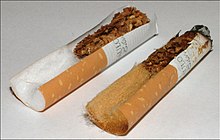The Evolution of Cigarette Filters: Reducing Harmful Elements in Smoking

Photo by Clker-Free-Vector-Images on Pixabay

Cigarette smoking has long been associated with adverse health effects, including lung cancer and other respiratory diseases. In an effort to mitigate these risks, filters were introduced in the early 1950s as a component of cigarettes. The primary purpose of cigarette filters is to reduce the harm caused by smoking by reducing the inhalation of harmful elements. This article will explore the evolution of cigarette filters, the materials used in their manufacture, their effectiveness in reducing harm, and the environmental impact of discarded filters.
History of Cigarette Filters
The concept of using filters in cigarettes can be traced back to the 1920s when Hungarian inventor Boris Aivaz patented the process of making a cigarette filter from crepe paper. However, it wasn’t until the 1950s that filters gained widespread popularity. The introduction of filters was driven by growing concerns about the health risks associated with smoking and the desire to create a perception of reduced harm.
Types of Cigarette Filter Materials
Cigarette filters are typically made from plastic cellulose acetate fiber, although other materials such as paper and activated charcoal have also been used. Cellulose acetate is derived from esterifying bleached cotton or wood pulp with acetic acid. The resulting material is spun into fibers and formed into bundles known as filter tow.
Impact of Cigarette Filters on Harm Reduction
The effectiveness of cigarette filters in reducing harm has been a subject of debate. Laboratory tests have shown that filters can reduce the levels of “tar” and nicotine in cigarette smoke. However, filters are ineffective at removing gases of low molecular weight, such as carbon monoxide. It is important to note that the measured reductions in harmful elements often occur only when cigarettes are smoked on a machine. When smoked by a human, the compounds are still delivered into the lungs regardless of whether a filter is used.
Health Risks and Benefits
The introduction of cigarette filters has been associated with both health risks and benefits. Epidemiological studies in the 1970s suggested a reduced risk of lung cancer and coronary heart disease among filter smokers. However, later studies indicated a similar risk for lung cancer in smokers of filtered and non-filtered cigarettes. The risk reductions associated with filter cigarettes depend on various factors such as gender, athletic activity, age, and cigarette consumption.
The Illusion of Filtration
The tobacco industry recognized the importance of the perception of filtration, even if the actual filtration was minimal. The color-changing filter was invented in 1953 by Claude Teague, who worked for the R.J. Reynolds Tobacco Company. The pH of the cellulose acetate used in filters is modified to darken the color when exposed to smoke. This illusion of filtration was aimed at marketing filtered cigarettes as effective, despite not actually reducing the health risks associated with smoking.
Manufacturing and Safety
The manufacturing process of cigarette filters involves gluing the filter seams and bonding the filters to the cigarettes using starch glues or emulsion-based adhesives. Cellulose acetate, the primary material used in filters, is non-toxic, odorless, tasteless, and weakly flammable. It is resistant to weak acids and stable to mineral and fatty oils. Smoked cigarette butts containing cellulose acetate can biodegrade over time, passing through the stage of microplastics.
Environmental Impact and Waste Management
Cigarette butts are the most littered waste item in the world, with trillions of butts discarded each year. The plastic cellulose acetate in cigarette butts can leach toxins into the environment, including nicotine, arsenic, and polycyclic aromatic hydrocarbons. Various initiatives have been proposed to address the environmental impact of cigarette filters, such as developing biodegradable filters, implementing monetary deposits on filters, increasing the availability of cigarette receptacles, and expanding public education.
Innovations in Cigarette Filter Waste
Researchers have been exploring ways to repurpose cigarette filter waste. One group in South Korea has developed a process that converts cellulose acetate in discarded filters into a high-performing supercapacitor electrode material. This material has shown superior performance compared to commercially available carbon and graphene. Another proposed solution involves adding tablets of food-grade acid inside filters to accelerate degradation.
Conclusion
Cigarette filters have evolved over the years in an attempt to reduce the harm caused by smoking. While they have shown some effectiveness in reducing certain harmful elements in smoke, they are not capable of eliminating all risks associated with smoking. The environmental impact of discarded filters is a growing concern, and efforts are being made to develop more sustainable alternatives. It is important for individuals to be aware of the health risks associated with smoking and to consider quitting or seeking healthier alternatives.
